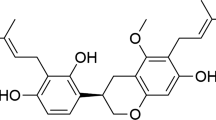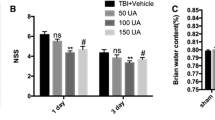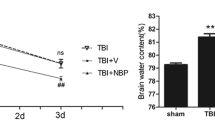Abstract
Traumatic brain injury (TBI) is one of the major causes of death and disability worldwide. Novel and effective therapy is needed to prevent the secondary spread of damage beyond the initial injury. The aim of this study was to investigate whether berberine has a neuroprotective effect on secondary injury post-TBI, and to explore its potential mechanism in this protection. The mice were randomly divided into Sham-saline, TBI-saline and TBI-Berberine (50 mg/kg). TBI was induced by Feeney’s weight-drop technique. Saline or berberine was administered via oral gavage starting 1 h post-TBI and continuously for 21 days. Motor coordination, spatial learning and memory were assessed using beam-walking test and Morris water maze test, respectively. Brain sections were processed for lesion volume assessment, and expression of neuronal nuclei (NeuN), cyclooxygenase 2 (COX-2), inducible nitric oxide synthase (iNOS), 8-hydroxy-2-deoxyguanosine (8-OHdG), ionized calcium-binding adapter molecule 1 (Iba1) and glial fibrillary acidic protein (GFAP) were detected via immunohistochemistry and immunofluorescence. There were statistically significant improvement in motor coordination, spatial learning and memory in the TBI-Berberine group, compared to the TBI-saline group. Treatment with berberine significantly reduced cortical lesion volume, neuronal loss, COX-2, iNOS and 8-OHdG expression in both the cortical lesion border zone (LBZ) and ipsilateral hippocampal CA1 region (CA1), compared to TBI-saline. Berberine treatment also significantly decreased Iba1- and GFAP-positive cell number in both the cortical LBZ and ipsilateral CA1, relative to saline controls. These results indicated that berberine exerted neuroprotective effects on secondary injury in mice with TBI probably through anti-oxidative and anti-inflammatory properties.








Similar content being viewed by others
References
Hyder AA, Wunderlich CA, Puvanachandra P, Gururaj G, Kobusingye OC (2007) The impact of traumatic brain injuries: a global perspective. NeuroRehabilitation 22(5):341–353
Bramlett HM, Dietrich WD (2002) Quantitative structural changes in white and gray matter 1 year following traumatic brain injury in rats. Acta Neuropathologica 103(6):607–614
Liu YR, Cardamone L, Hogan RE, Gregoire MC, Williams JP, Hicks RJ, Binns D, Koe A, Jones NC, Myers DE, O’Brien TJ, Bouilleret V (2010) Progressive metabolic and structural cerebral perturbations after traumatic brain injury: an in vivo imaging study in the rat. J Nucl Med 51(11):1788–1795
Davis AE (2000) Mechanisms of traumatic brain injury: biomechanical, structural and cellular considerations. Crit Care Nurs Q 23(3):1–13
Raghupathi R (2004) Cell death mechanisms following traumatic brain injury. Brain Pathol 14(2):215–222
Bramlett HM, Dietrich WD (2004) Pathophysiology of cerebral ischemia and brain trauma: similarities and differences. J Cereb Blood Flow Metab 24(2):133–150
Werner C, Engelhard K (2007) Pathophysiology of traumatic brain injury. Br J Anaesth 99(1):4–9
Cornelius C, Crupi R, Calabrese V, Graziano A, Milone P, Pennisi G, Radak Z, Calabrese EJ, Cuzzocrea S (2013) Traumatic brain injury: oxidative stress and neuroprotection. Antioxid Redox Signal 19(8):836–853
Crack PJ, Taylor JM (2005) Reactive oxygen species and the modulation of stroke. Free Radic Biol Med 38(11):1433–1444
Hsieh HL, Yang CM (2013) Role of redox signaling in neuroinflammation and neurodegenerative diseases. BioMed Res Int 2013:484613
Ikram M (1975) A review on the chemical and pharmacological aspects of genus Berberis. Planta Med 28(08):353–358
Siow YL, Sarna L, Karmin O (2011) Redox regulation in health anddisease-therapeutic potential of berberine. Food Res Int 44:2409–2417
Lee IA, Hyun YJ, Kim DH (2010) Berberine ameliorates TNBS-induced colitis by inhibiting lipid peroxidation, enterobacterial growth and NF-κB activation. Eur J Pharmacol 648(1):162–170
Wang X, Wang R, **ng D, Su H, Ma C, Ding Y, Du L (2005) Kinetic difference of berberine between hippocampus and plasma in rat after intravenous administration of Coptidisrhizoma extract. Life Sci 77(24):3058–3067
Ye M, Fu S, Pi R, He F (2009) Neuropharmacological and pharmacokinetic properties of berberine: a review of recent research. J Pharm Pharmacol 61(7):831–837
Hong JS, Chu YK, Lee H, Ahn BH, Park JH, Kim MJ, Lee S, Ryoo HS, Jang JH, Lee SR, Park JW (2012) Effects of berberine on hippocampal neuronal damage and matrix metalloproteinase-9 activity following transient global cerebral ischemia. J Neurosci Res 90(2):489–497
Zhang J, Yang JQ, He BC, Zhou QX, Yu HR, Tang Y, Liu BZ (2009) Berberine and total base from rhizomacoptischinensis attenuate brain injury in an aluminum-induced rat model of neurodegenerative disease. Saudi Med J 30(6):760–766
Durairajan SS, Liu LF, Lu JH, Chen LL, Yuan Q, Chung SK, Huang L, Li XS, Huang JD, Li M (2012) Berberine ameliorates β-amyloid pathology, gliosis, and cognitive impairment in an Alzheimer’s disease transgenic mouse model. Neurobiol Aging 33(12):2903–2919
Chen CC, Hung TH, Lee CY, Wang LF, Wu CH, Ke CH, Chen SF (2014) Berberine protects against neuronal damage via suppression of glia-mediated inflammation in traumatic brain injury. PLoS ONE 9(12):e115694
Feeney DM, Boyeson MG, Linn RT, Murray HM, Dail WG (1981) Responses to cortical injury: I. Methodology and local effects of contusions in the rat. Brain Res 211(1):67–77
Kumar A, Mishra J, Chopra K, Dhull DK (2016) Possible role of P-glycoprotein in the neuroprotective mechanism of berberine in intracerebroventricularstreptozotocin-induced cognitive dysfunction. Psychopharmacology 233(1):137–152
Loane DJ, Pocivavsek A, Moussa CE, Thompson R, Matsuoka Y, Faden AI, Rebeck GW, Burns MP (2009) Amyloid precursor protein secretases as therapeutic targets for traumatic brain injury. Nat Med 15(4):377–379
Dixon CE, Bramlett HM, Dietrich WD, Shear DA, Yan HQ, Deng-Bryant Y, Mondello S, Wang KK, Hayes RL, Empey PE, Povlishock JT, Tortella FC, Kochanek PM (2016) Cyclosporine treatment in traumatic brain injury: operation brain trauma therapy. J Neurotrauma 33(6):553–566
Zilles K (2012) The cortex of the rat: a stereotaxic atlas. Springer, Berlin
Dash PK, Orsi SA, Zhang M, Grill RJ, Pati S, Zhao J, Moore AN (2010) Valproate administered after traumatic brain injury provides neuroprotection and improves cognitive function in rats. PLoS ONE 5(6):e11383
Mullen RJ, Buck CR, Smith AM (1992) NeuN, a neuronal specific nuclear protein in vertebrates. Development 116(1):201–211
Loane DJ, Faden AI (2010) Neuroprotection for traumatic brain injury: translational challenges and emerging therapeutic strategies. Trends Pharmacol Sci 31(12):596–604
Cernak I, Vink R, Zapple DN, Cruz MI, Ahmed F, Chang T, Fricke ST, Faden AI (2004) The pathobiology of moderate diffuse traumatic brain injury as identified using a new experimental model of injury in rats. Neurobiol Dis 17(1):29–43
Malkesman O, Tucker LB, Ozl J, McCabe JT (2013) Traumatic brain injury-modeling neuropsychiatric symptoms in rodents. Front Neurol 4:157
Kheir MM, Wang Y, Hua L, Hu J, Li L, Lei F, Du L (2010) Acute toxicity of berberine and its correlation with the blood concentration in mice. Food Chem Toxicol 48(4):1105–1110
Zhu F, Qian C (2006) Berberine chloride can ameliorate the spatial memory impairment and increase the expression of interleukin-1beta and inducible nitric oxide synthase in the rat model of Alzheimer’s disease. BMC Neurosci 7(1):78
Ding K, Wang H, Wu Y, Zhang L, Xu J, Li T, Ding Y, Zhu L, He J (2015) Rapamycin protects against apoptotic neuronal death and improves neurologic function after traumatic brain injury in mice via modulation of the mTOR-p53-Bax axis. J Surg Res 194(1):239–247
Lenzlinger PM, Marx A, Trentz O, Kossmann T, Morganti-Kossmann MC (2002) Prolonged intrathecal release of soluble Fas following severe traumatic brain injury in humans. J Neuroimmunol 122(1):167–174
Merrill DA, Chiba AA, Tuszynski MH (2001) Conservation of neuronal number and size in the entorhinal cortex of behaviorally characterized aged rats. J Comp Neurol 438(4):445–456
McHugh TJ, Jones MW, Quinn JJ, Balthasar N, Coppari R, Elmquist JK, Lowell BB, Fanselow MS, Wilson MA, Tonegawa S (2007) Dentate gyrus NMDA receptors mediate rapid pattern separation in the hippocampal network. Science 317(5834):94–99
Rodriguez-Rodriguez A, Egea-Guerrero JJ, Murillo-Cabezas F, Carrillo-Vico A (2014) Oxidative stress in traumatic brain injury. Curr Med Chem 21(10):1201–1211
Franklin JL (2011) Redox regulation of the intrinsic pathway in neuronal apoptosis. Antioxid Redox Signal 14(8):1437–1448
Clark RS, Kochanek PM, Schwarz MA, Schiding JK, Turner DS, Chen M, Carlos TM, Watkins SC (1996) Inducible nitric oxide synthase expression in cerebrovascular smooth muscle and neutrophils after traumatic brain injury in immature rats 1. Pediatr Res 39(5):784–790
Petrov T, Page AB, Owen CR, Rafols JA (2000) Expression of the inducible nitric oxide synthase in distinct cellular types after traumatic brain injury: an in situ hybridization and immunocytochemical study. Acta Neuropathol 100(2):196–204
Iadecola C, Zhang F, Xu X (1995) Inhibition of inducible nitric oxide synthase ameliorates cerebral ischemic damage. Am J Physiol Regul Integr Comp Physiol 268(1):R286–R292
Zhao Y, Patzer A, Herdegen T, Gohlke P, Culman J (2006) Activation of cerebral peroxisome proliferator-activated receptors gamma promotes neuroprotection by attenuation of neuronal cyclooxygenase-2 overexpression after focal cerebral ischemia in rats. FASEB J 20(8):1162–1175
Im JY, Kim D, Paik SG, Han PL (2006) Cyclooxygenase-2-dependent neuronal death proceeds via superoxide anion generation. Free Radic Biol Med 41(6):960–972
Dalle-Donne I, Rossi R, Colombo R, Giustarini D, Milzani A (2006) Biomarkers of oxidative damage in human disease. Clin Chem 52(4):601–623
Mendez DR, Cherian L, Moore N, Arora T, Liu PK, Robertson CS (2004) Oxidative DNA lesions in a rodent model of traumatic brain injury. J Trauma Acute Care Surg 56(6):1235–1240
Haces ML, Montiel T, Massieu L (2010) Selective vulnerability of brain regions to oxidative stress in a non-coma model of insulin-induced hypoglycemia. Neuroscience 165(1):28–38
White BC, Sullivan JM, DeGracia DJ, O’Neil BJ, Neumar RW, Grossman LI, Rafols JA, Krause GS (2000) Brain ischemia and reperfusion: molecular mechanisms of neuronal injury. J Neurolog Sci 179(S1–2):1–33
Wang J, Zhang Y (2018) Neuroprotective effect of berberine agonist against impairment of learning and memory skills in severe traumatic brain injury via Sirt1/p38 MAPK expression. Mol Med Rep 17(5):6881–6886
Khan M, Im YB, Shunmugavel A, Gilg AG, Dhindsa RK, Singh AK, Singh I (2009) Administration of S-nitrosoglutathione after traumatic brain injury protects the neurovascular unit and reduces secondary injury in a rat model of controlled cortical impact. J Neuroinflamm 6(1):32
Thau-Zuchman O, Shohami E, Alexandrovich AG, Trembovler V, Leker RR (2012) The anti-inflammatory drug carprofen improves long-term outcome and induces gliogenesis after traumatic brain injury. J Neurotrauma 29(2):375–384
Zhang D, Teng J (2016) Nrf2 knockout: the effect on neurological dysfunction and the activation of glial cells of mice after brain injury. Pak J Pharm Sci 29(4 Suppl):1365–1369
Laird MD, Vender JR, Dhandapani KM (2008) Opposing roles for reactive astrocytes following traumatic brain injury. Neurosignals 16(2–3):154–164
Karve IP, Taylor JM, Crack PJ (2016) The contribution of astrocytes and microglia to traumatic brain injury. Br J Pharmacol 173(4):692–702
Garcia JM, Stillings SA, Leclerc JL, Phillips H, Edwards NJ, Robicsek SA, Hoh BL, Blackburn S, Dore S (2017) Role of interleukin-10 in acute brain injuries. Front Neurol 8:244
Funding
This work was supported by the Natural Science Foundation of Guangdong Province China (S2013010015786), (2015A030310294) and the Natural Science Foundation of Shaoguan City, Guangdong Province, China (2010-01).
Author information
Authors and Affiliations
Corresponding author
Ethics declarations
Conflict of interest
The authors declare no conflict of interest.
Rights and permissions
About this article
Cite this article
Huang, SX., Qiu, G., Cheng, FR. et al. Berberine Protects Secondary Injury in Mice with Traumatic Brain Injury Through Anti-oxidative and Anti-inflammatory Modulation. Neurochem Res 43, 1814–1825 (2018). https://doi.org/10.1007/s11064-018-2597-5
Received:
Revised:
Accepted:
Published:
Issue Date:
DOI: https://doi.org/10.1007/s11064-018-2597-5




